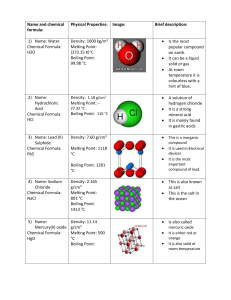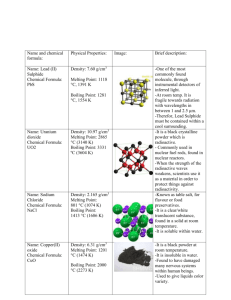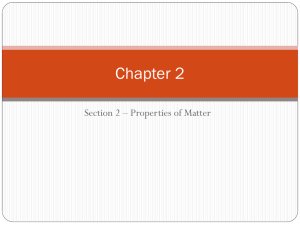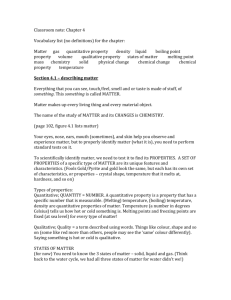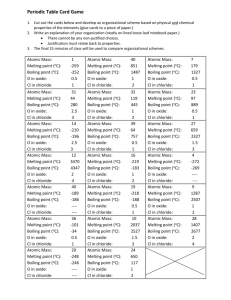Atom @tak compounds
advertisement
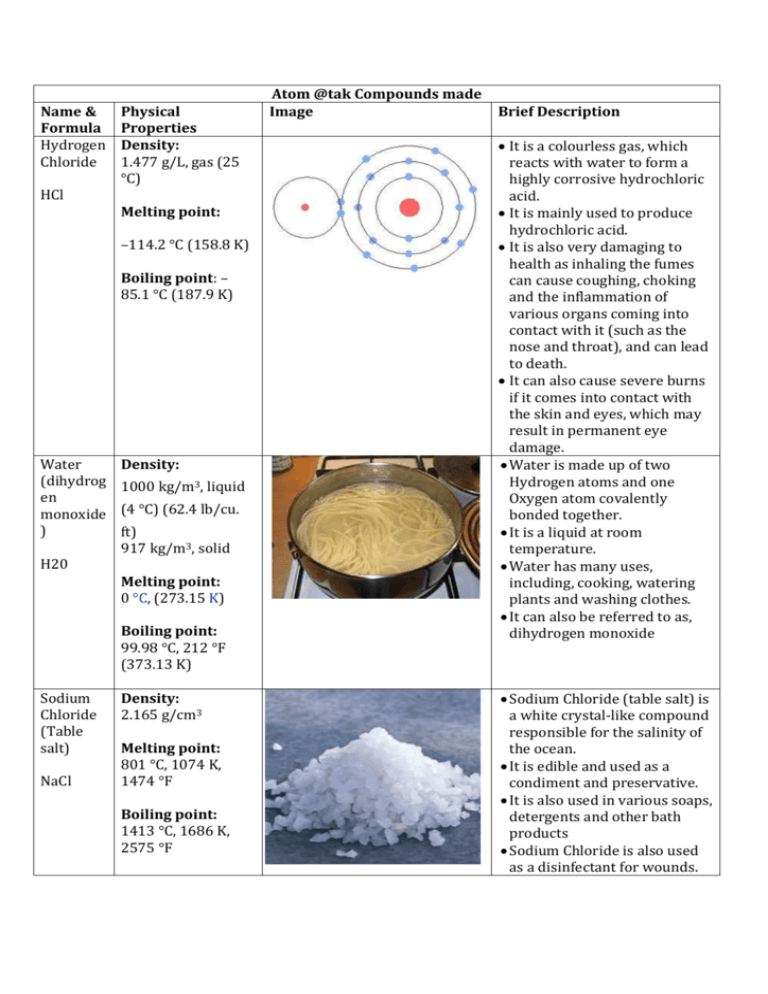
Name & Formula Hydrogen Chloride HCl Physical Properties Density: 1.477 g/L, gas (25 °C) Melting point: –114.2 °C (158.8 K) Boiling point: – 85.1 °C (187.9 K) Water (dihydrog en monoxide ) H20 Density: 1000 kg/m3, liquid (4 °C) (62.4 lb/cu. ft) 917 kg/m3, solid Melting point: 0 °C, (273.15 K) Boiling point: 99.98 °C, 212 °F (373.13 K) Sodium Chloride (Table salt) NaCl Density: 2.165 g/cm3 Melting point: 801 °C, 1074 K, 1474 °F Boiling point: 1413 °C, 1686 K, 2575 °F Atom @tak Compounds made Image Brief Description It is a colourless gas, which reacts with water to form a highly corrosive hydrochloric acid. It is mainly used to produce hydrochloric acid. It is also very damaging to health as inhaling the fumes can cause coughing, choking and the inflammation of various organs coming into contact with it (such as the nose and throat), and can lead to death. It can also cause severe burns if it comes into contact with the skin and eyes, which may result in permanent eye damage. Water is made up of two Hydrogen atoms and one Oxygen atom covalently bonded together. It is a liquid at room temperature. Water has many uses, including, cooking, watering plants and washing clothes. It can also be referred to as, dihydrogen monoxide Sodium Chloride (table salt) is a white crystal-like compound responsible for the salinity of the ocean. It is edible and used as a condiment and preservative. It is also used in various soaps, detergents and other bath products Sodium Chloride is also used as a disinfectant for wounds. Copper (II) Oxide Density: 6.31 g/cm3 CuO Melting point: 1201 °C (1474 K) Boiling point: 2000 °C Mercury Oxide Density: 11.14 g/cm3 HgO Melting point: 500 °C (decomposes) Boiling point: Sodium cyanide Density: 1.595 g/cm3 Na(CN) Melting point: 563.7 °C Boiling point: 1496 °C Potassiu m Bromide Density: 2.75 g/cm3 Copper Oxide is a compound made up of one atom of Copper and one of Oxygen. It is used as a pigment in ceramics to produce blue, red, green and occasionally black, pink and grey glazes. Copper (II) Oxide can also be used to safely dispose of hazardous materials such as Cyanide, Hydrocarbons, Halogenated Hydrocarbons and dioxins. When it comes into contact with the skin or eyes, Copper Oxide can cause irritation and if ingested (swallowed) it can lead to blood cells rupturing, circulatory collapse and shock. Mercury oxide is red or orange in colour and is a solid at room temperature. It is used to produce mercury as it decomposes easily. It is also used in mercury batteries Mercury Oxide is a very toxic substance and can cause irritation to the eyes, skin and respiratory tracts and can cause kidney impairment. It also reacts violently with certain agents such as chlorine and hydrogen peroxide. Sodium cyanide is a highly toxic salt. It is mainly used in mining to extract gold from other precious minerals. It can also be used to stun or kill rapidly just like in cyanide fishing. Sodium Cyanide is also, as mentioned above, highly toxic and is therefore quite poisonous as well. Potassium Bromide is a whit crystalline powder/salt. It is used as a KBr Melting point: 734 °C, 1007 K, Boiling point: 1435 °C, 1708 K, Uranium dioxide Density: 10.97 g/cm3 UO2 Melting point: 2865 °C (3140 K) Boiling point: Lead (II) Sulfide Density: 7.60 g/cm3 PbS Melting point: 1118 °C Boiling point: 1281 °C Phosgene Density: COCl2 4.248 g/cm3 (15 °C) 1.432 g/cm3 (0 °C) Melting point: −118 °C, 155 K, 180 °F Boiling point: 8.3 °C, 281 K, 47 °F Sources: http://en.wikipedia.org/wiki/Hydrogen_chloride treatment/medication for epilepsy and seizures in dogs and sometimes in cats. It is not often used for cats as it can cause lung inflammation. In the US it is not approved for use in humans to control seizures, however, in Germany it is approved for use in humans. It is a black crystalline powder that is naturally occurring in the mineral, Uraninite It is radioactive and is therefore used in nuclear fuel rods and in nuclear reactors. It was also used to colour glass and various ceramics Lead (II) sulfide is an inorganic compound (doesn’t contain Carbon). It is used to detect and measure radiation. Lead (II) Sulfide is can also be toxic if it is heated to the point of decomposition (like in a fire), in which, toxic compounds of lead and Sulfur Oxides will be produced. Phosgene is a colourless gas. It was used as a chemical weapon in World War I. It is a poison with symptoms that appear slowly. It is also highly toxic and can cause suffocation when inhaled. http://en.wikipedia.org/wiki/Sodium_cyanide http://en.wikipedia.org/wiki/Lead(II)_sulfide http://en.wikipedia.org/wiki/Uranium_dioxide http://en.wikipedia.org/wiki/Mercury_oxide http://en.wikipedia.org/wiki/Sodium_chloride http://en.wikipedia.org/wiki/Copper_(II)_oxide http://en.wikipedia.org/wiki/Potassium_bromide http://en.wikipedia.org/wiki/Water http://en.wikipedia.org/wiki/Carbon_dichloride_oxide
